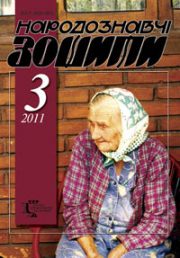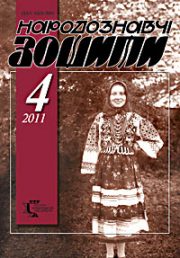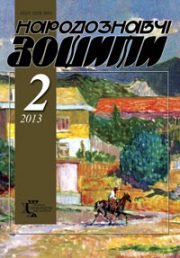The Ethnology Notebooks. 2022. № 5 (167), 1133—1146
UDK [069.5:7.01:316.422](477)”19/20″:930.85
DOI https://doi.org/10.15407/nz2022.05.1113
KUSHNIR Vitalii
- ORCID ID: https://orcid.org/0000-0001-8809-0108
- Candidate of Historical Sciences, Research Fellow,
- Museum of Ethnography and Art Crafts;
- Of the Institute of Ethnology of the National Academy of Science of Ukraine
- Svobody ave., 15, 79000. Lviv, Ukraine,
- Contacts: e-mail: vitaliy_val@ukr.net
Abstract. Political and socio-cultural changes are always accompanied by changes in society’s understanding of its own past, causing a transformation of the «intellectual optics» through which society sees its history and cultural heritage. The assertion of a new coordinate system in its assessment often changes the «landscape of the past» almost beyond recognition. In this context, museums are one of the main tools for creating a «biography of the country», defining its heroes and anti-heroes, highlighting what is important for contemporaries or, on the contrary, worthy of condemnation or even oblivion.
The purpose of the article is to analyze the influence of political changes and changes in the state policy of memory in Ukraine during the period of independence on the representation of Ukrainian historical and cultural heritage in permanent and temporal exhibitions of Ukrainian museums. The focus of attention in the paper is on changes in the interpretation of the history of Ukraine of the 20th century, primarily its communist period, as well as changes in the representation of the artistic heritage of the Soviet era. Special attention is paid to transformations in the museum narrative of the history of Ukrainian lands during the Second World War.
The chronological framework of the work covers the period since 1991, with several excursions during the so-called «perestroika» of the late 1980s, and until the end of 2021 — the time on the eve of a large-scale Russian invasion of Ukraine.
Conclusions. Museums are one of the main instruments of memory policy, which construct and represent to society a certain image of its past, historical and cultural heritage. Ukraine’s independence in 1991 became a prerequisite for fundamental changes in the museum image of Ukrainian history, its departure from the imperial and «Soviet» paradigm. At the center of this process was primarily the topic related to the «Soviet» period of national history, the struggle of the Ukrainian national liberation movement of the 20th century. One of the most tense was the question of Ukraine’s role in the Second World War and the concept of the «Great Patriotic War». Political and legal changes in our country eventually led to the abandonment of this term, but did not eliminate objective contradictions in the situation of Ukrainian territories during the war years. In this context, the museum’s interpretation of the events of the Second World War on the territory of Ukraine has generally shifted towards showing, first of all, their extremely tragic humanitarian dimension and the concept of the «struggle of Ukrainians against two totalitarian regimes».
Keywords: museums, politics of memory, World War II, decommunization, Soviet art.
Received 6.09.2022
REFERENCES
- Verbytska, P. (2014). The historical museum as a factor of reconciliation and social dialogue. Historical and Cultural Studies, 1 (Vol. 1, pp. 13—17) [in Ukrainian].
- Yakovenko, N. (2007). Introduction to history. Kyiv: Krytyka [in Ukrainian].
- Kharhun, Valentina. Communism as a museum exhibit: Soviet heritage — the object of memory politics in Ukraine. Retrieved from: uamoderna.com/demontazh-pamiati/khrakhun-communism… (date of access: May 17, 2022) [in Ukrainian].
- Lyubarets, A. (2016). Commemoration of May 9 as a mirror of Ukrainian politics of memory. Actual problems of national and world history (Issue 28, pp. 176—189) [in Ukrainian].
- Hrynevych, Vladyslav. (2011, July-August). Politics of World War II memory in Ukraine: in search of identity and consolidation. IPiENR named after I.F. Kuras NAS of Ukraine; Proceedings (Issue 4 (54), pp. 111—127) [in Ukrainian].
- Khakhula, Lubomyr, & Ilnytskyi, Vasyl. (2020). Modern Ukrainian museum narratives as factors of detraumatization of the memory of totalitarianism of the 20th century. Problems of humanitarian sciences: Collection of scientific works of Ivan Franko Drohobych State Pedagogical University. History series, 4/45/, 347—370. Doi: https://doi.org/10.24219/2312-2595 4/46.215328 [in Ukrainian].
- Dovhanyk, N.M. Historical memory of the Second World War in the context of the formation of the Ukrainian political nation (Pp. 34—40). Retrieved from: babynyar.org/storage/library/digital-articles/9a/8d/120S0017_file.pdf (date of access: June 9, 2022) [in Ukrainian].
- Retrieved from: https://lps.ligazakon.net/document/T150317? an=54 (date of access: June 9, 2022).
- Babka, V. (2014). Politics of memory: an attempt at theoretical synthesis, models of implementation and role in a transitional society. IPiENR named after I.F. Kuras NAS of Ukraine; Proceedings (Issue 6 (74), pp. 201—215) [in Ukrainian].
- (2017). Museum of the Second World War. Methodical recommendations for the design of thematic expositions of military-historical museums. Kyiv [in Ukrainian].
- Lytvynenko, O.M. Problems of decommunization of the memorial space of Ukraine. Retrieved from: www.niss.gov.ua/sites/2016-07/dekomunizasia-1065b.pdf (date of application: 29.06.2022) [in Ukrainian].
- Kostyantyn, Doroshenko. How the Kmitiv Museum named after Bukhanchuk interacts with modern art. Retrieved from: https://suspilne.media/6135-ak-kmitivskij-muzej… (access date: June 25, 2022) [in Ukrainian].
- Decommunization or deheroization? Kostyantyn Doroshenko on the legacy of the totalitarian past. December 17, 2019. Retrieved from: https://suspilne.media/4878-decomunizacia-ci-degeroizacia… [in Ukrainian].
- To carry out decommunization is to remove all ideological «layers of old paint and create a space in which the visitor can draw his own conclusions — Lesya Hasydzhak. S. 1/4. Retrieved from: https://uacrisis.org/uk/42125-provesti-decomunizatsiu… 04/13/2016 (application date: 07/02/2022) [in Ukrainian].
- Soviet art: propaganda or heritage? Retrieved from: https://zahid.espresso.tv/article/2020/10/01/radianske_mystectvo… (access date: 07/02/2022) [in Ukrainian].
- Kmytiv Museum of Soviet Art and Evgenia Molyar. Retrieved from: supportyouart.com/conversations/kmpmmolyar/ (access date: 07/05/2022) [in Ukrainian].
- Exhumation. Social realism from the collection of the Okhm. 15.XII.2018—25.II.2019. Retrieved from: www.ofam.org.ua/exgumation (access date: July 21, 2022) [in Ukrainian].
- Oleksandr Udovenko. «Red Noise». Exhibition of Soviet propaganda art. Retrieved from: www.kyivhistorymuseum.org/uk/vystavkovi-proekty/chervonyj-shum… (access date: 06/24/2022) [in Ukrainian].
- Retrieved from: www.bbc.com/ukrainian/features-41814209 (access date: July 21, 2022).







